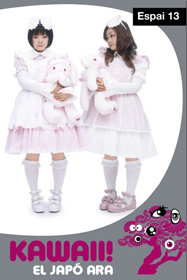Tomoko Sawada
dal 3/4/2008 al 17/5/2008
Segnalato da
3/4/2008
Tomoko Sawada
Fundacio Joan Miro', Barcelona
Identities. The young Japanese today are characterised by their extravagant dress or by their dreams of obtaining luxury articles, as part of a search for identity. Sawada questions this phenomenon with its infinite metamorphoses in the series of photographs in which she gets inside the skin of hundreds of Japanese girls. Curated by Helene Kelmachter.

Curator: Hélène Kelmachter
The young Japanese today are characterised by their extravagant dress or by their dreams of obtaining luxury articles, as part of a search for identity. Tomoko Sawada, one of the most innovative and talented artists of her generation, questions this phenomenon with its infinite metamorphoses in the series of photographs in which she gets inside the skin of hundreds of Japanese girls.
I’m another…
The work of Tomoko Sawada (Kobe, 1977) is open to a number of sociological and psychological interpretations. The way her lens captures dozens of Japanese girls and women of different ages and social classes raises in the most natural way the question of the place occupied by Japanese females in society, the possibilities that each one has of achieving an individual identity, and the way in which dress can help to individualise them or, on the contrary, confirm their membership of a group.
At the age of twenty-two, Tomoko Sawada produced one of her first series, ID 400 (1999), a hundred passport-sized black-and-white photos: good girls and naughty girls, classical and modern girls, girls with thick or plucked eyebrows. The series was produced with the minimum of technical resources: a photo machine at a petrol station. After this set of individual photos, Sawada began to explore in the opposite direction: group photographs, with a series of class photos in which the uniformed girls are the artist herself (School Days, 2006).
Fashion victims and new standards
Young Japanese girls today, however, live in much more emancipated times, as demonstrated by the series Cover (2004) now on show at the Joan Miró Foundation. Tomoko Sawada appears here looking like the girls in the Shibuya district of Tokyo, who rival each other in extravagance and inventiveness: fluorescent colours, imitation fur coats in acid colours, the briefest of mini-skirts and high platform heels all create a look that confirms the search for an identity and a transformation of the traditional female role in Japanese society. As well as following a dress code, the change of image also seeks to imitate the cover girls on magazines: bleached hair, over-tanned skin and lavish make-up create a social mask and a common identity.
Gothic and Kawaii
For the exhibition in the Espai 13 at the Joan Miró Foundation, Tomoko Sawada has created a new series of photographs – Decoration – in which she portrays a way of dressing that can be seen in particular in the Harajuku district in Tokyo: the Gothic Lolitas. It is characterised by layers of lace petticoats, ribboned bonnets, black leather or vinyl corsets, and hair curled or in ringlets. Every Sunday, the “Gothloli” girls can be seen at the entrance to Takeshita Dori, a well-known street in Tokyo. They look like porcelain dolls and strike the most Kawaii poses in front of the cameras of professional and amateur photographers. Rather than a disguise – like the cosplays that appear at manga gatherings and festivals – the Gothic Lolita style can be found in many towns and cities in Japan, especially Osaka. This trend, which emerged in 1998, became popular in the early years of the century with the appearance of various brands of clothing. One of the best known, Baby the Stars Shine, left its collections to Tomoko Sawada for this new series of photographs. In addition to this particular fashion, the artist explores the subject of uniformity and delves further into the idea of identity, likeness and individuality that can be found throughout her work. She was fascinated by this practice and consequently tried to find a way of appropriating it. This exhibition in the Espai 13 has given her the opportunity to do so.
The exhibition has been organised with the collaboration of Galeria MEM, Osaka and with the support of Baby the Stars Shine.
The catalogue will be published by Éditions Akaaka.
Espai 13
From the outset, the Joan Miró Foundation has paid special attention to the work of young experimental artists, who have their own exhibition area — the Espai 13.
The programming for the Espai 13 is organised in cycles that coincide with the academic year, from October-June. The artists are selected by the curator of each cycle, who is unconnected with the Foundation and is generally an art critic. This method not only favours the work of young artists, but also encourages the new generation of art critics.
The idea of each exhibition developing around the central theme of each cycle gives a sense of coherence and purpose to the artists involved.
The special features of the exhibition space, with its somewhat industrial atmosphere, is ideal for presenting very varied types of work.
The exhibitions in the Espai 13 are usually accompanied by a small leaflet with illustrations of the pieces and texts in Catalan, Spanish and English.
Joan Miró Foundation
Parc de Montjuïc, s/n 08038 Barcelona
Opening hours
Tuesdays to Saturdays
10.00 - 19.00 (October-June)
10.00 - 20.00 (July-September)
Thursdays 10.00 - 21.30
Sundays and public holidays 10.00 - 14.30
Mondays (except public holidays) Closed



